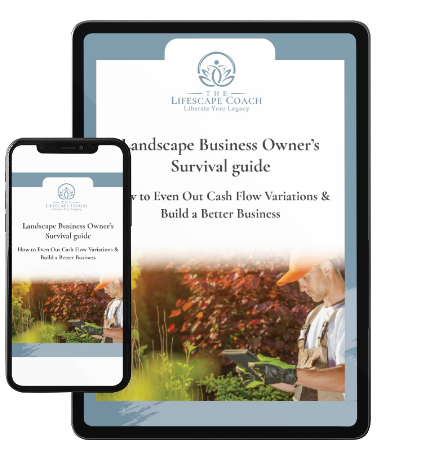10 Time Management Tips for Landscape Professionals
Time seems to get away from a lot of us. Most of us never seem to have enough time to get things done, both personally and professionally. That may be okay when it comes to finding the time to clean out the garage, but for landscape professionals we have the added pressure of dealing with seasonal highs and lows, staffing issues, and weather disruptions that can rob us of precious time at the worst possible moments. But, as renowned sales and performance coach Michael Altshuler says, “The bad news is time flies. The good news is you’re the pilot.”
The solution begins with a little discipline. Stop blaming the weather, your staff, and even your clients and start developing a clear, actionable framework around how business gets organized and delivered. Make sure everyone on staff understands that structure and then hold them accountable to it. This provides the foundation for how you reliably deliver services and takes the guesswork and jury-rigging out of day-to-day operations. It helps prevent the tail wagging the dog and stops the ripple effect that can trigger a chain reaction as one project glitch affects all the projects behind it.
This kind of organized framework will not only help you internally, it will create a more positive outward impression for your company. One of the compliments I have enjoyed for most of my career is that I am organized. This isn’t just dumb luck – it comes from working hard to build a system around which my business and my day revolves.
Now, some might say that I’m overly structured, that I don’t allow enough free and unscheduled time for spontaneity. My answer to that is that I work in contingencies – I always have a Plan B for when Plan A goes up in flames – so that I am able to roll with the punches that will and do come up when running a service and contracting business that is subject to weather, vendor, and human nature hurdles.
With that in mind, I’m going to share with you the top 10 things that I’ve done as an owner to organize my time so that I can handle a large workload and not fall on my face in the process. These are the things that I do myself and that I require my staff to do – they are non-negotiables. This is MY business and I expect everyone who works for me to comply and work within the system that I’ve developed. It’s designed to help ALL of us succeed.
Now, make no mistake, I am fully open to suggestions on ways to improve this system. However – and this is a big one – I am NOT open to suggestions made simply to make things a little freer and easier for people because they bridle under what they perceive to be an unreasonable scheduling burden.
 Is mine the only way to do it? No. Time management is a highly personal and organizational thing. Each landscape business owner and their company is unique. The key is to find what works for you, your staff, and your business, implement it and maintain it.
Is mine the only way to do it? No. Time management is a highly personal and organizational thing. Each landscape business owner and their company is unique. The key is to find what works for you, your staff, and your business, implement it and maintain it.
The point is simply this – you need a system to succeed. Get it structured, get it documented, and get everyone on board. The only alternative is chaos.
So here are my tips.
Use them as you will: revise them, restructure them, even reject them and come up with your own. Hopefully they’ll help you figure out a way to make time management work for you:
- Require the use of a digital calendar by all managers
- Have a personal and a work calendar
- Color code all activities
- Time-block your calendar in advance
- Manage your calendar twice a week
- Use a scheduler application to automate client meetings
- Pre-schedule production each month
- Pre-schedule production each week
- Scheduled clients are emailed on Friday about production the following week
- When work is completed each account or project manager emails the client
#1 I require the use of a digital calendar by all managers -- we use Google Calendar. My calendar is shared with my support team. If they want to work with me on anything, they must look at my calendar and invite me to a meeting. Or if my schedule looks too “scary” to them, email me a meeting request. I do the same with them.
#2 I have a personal and a work calendar and integrate them so I can see both at the same time. This helps me stay accountable to my family. This is super important for all you workaholic-types out there. Family has to be worked in equitably.
#3 I color code all my activities. Think of it like buckets into which all things are divided:
- EMPLOYEE matters are all TEAL
- SALES & SERVICE matters are broken into subsections:
- Design is LIGHT BLUE
- Build is GREEN
- Fine Gardening is YELLOW
- Marketing is ROYAL BLUE
- CORPORATE matters such as legal, financial, and development are all a SOFT RED
…and there are a few other colors, but you get the point.
Coloring-coding these “buckets” enables me to quickly see what area I’ll be working on at any given time so I can tell in a glance if I am working my responsibilities evenly.
#4 I time-block my calendar in advance. Because I have direct reports that need me on a consistent basis, I preset meetings to ensure that I am engaging with them on a predictable and consistent basis. Meetings can be moved or rescheduled as needed, but they cannot be cancelled without the approval of both parties.
#5 I manage my calendar twice a week. Every Sunday night I review it to make sure my week will flow efficiently and I make adjustments as needed. I review my calendar again midweek to make sure I’ve made up for lost time, added missing elements, or freed up time where something has shifted. Being on top of your calendar a minimum of twice weekly is critical.
#6 I use an outside scheduler app that helps me automate the sales process. I’ve been using Schedule Once and it works very well. This enables sales leads to directly schedule time with me using a link to my personal and work calendars. This keeps my staff out of that loop, so they aren’t burdened unnecessarily and helps to give new leads direct access to me.
#7 We pre-schedule production each month on a huge 6’x4’ whiteboard so that we are always looking 30 days out for each division. Every week we review that monthly schedule and make tweaks as the month ticks away and as we need to respond to new information. Every client has a labeled magnet to represent them so we can move them around the board with ease and make notes with markers as needed.
#8 We pre-schedule production each week the week before. This is done in two phases: once on Wednesday and then we lock it in on Friday afternoon. This is then posted on another huge 6’x4’ whiteboard that’s in the same room as the monthly scheduler. Each client has a magnet -- and so does each employee, truck, and piece of equipment. This makes this board a powerhouse of information. There is NO WAY anyone can ever say, “Well, I didn’t know the plan.” They’d have to be blind not to know.
#9 All scheduled clients are emailed on Friday afternoon to inform them of the work plan for their property. In the email we tell them to please let us know if they have any questions, ideas, or concerns and if they need to meet with us.
We also state very clearly that all plans are subject to change due to weather or loss of staff. We will, of course, be in touch if that happens and let them know the adjusted plan. This is a canned email -- written once -- and just pulled up, tweaked, and sent. It takes about 15 minutes to get them all sent for the whole week. We learned in a client survey that 100% of our clients appreciate this communication, even though many admitted that they don’t even open it. It seems just getting it tips them off that we are coming and if they don’t have anything to tell us, they just let it sit.
#10 When work is completed each account or project manager emails the client with a progress and/or completion update -- either that day or that week, depending on whether it’s maintenance or construction work. This is also a pre-formatted email, making it very easy to pull up and start. The specific details are filled in to keep the client in the loop. Again, while clients seem to appreciate this communication tool, they also admit that if they come home and the place looks great, they often skip opening it. We’ve learned that if there is an issue, we need to make sure we note it in the subject line or they may miss it.
Make every minute matter.
No matter what we do, no one is ever going to “make” more time. There is never going to be a 25-hour day. It’s how we manage the time we have that counts. And that means managing our behavior and habits.
When everyone in your company is in-sync -- acting and working in unison -- things get done much more efficiently and reliably. But this only happens by developing and implementing a system that everyone willingly adopts. Without a time management system, you risk having people pulling in different directions creating a whole lot of unnecessary and unproductive pain.
A great time management system is fundamental to a successful organization, but the real key is good communications. Make a commitment to putting your communications and your goals in writing as a way to hold yourself and the people you work with and serve accountable for overall success. And remember, management systems are evolutionary. You don’t set them and forget them. They need attention over time to keep them aligned with your needs and your business growth.

Image Copyright: 123RF Stock Photo
Landscape Business Owners Survival Guide


